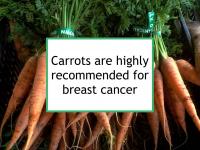Carrots (Daucus carota) have been shown to have antioxidant, antifungal, and antibacterial properties. They also suppress inflammation, promote good vision, and are cardioprotective. Carrots are an excellent dietary source of beta-carotene and alpha-carotene (both of which are converted in the body to vitamin A), as well as falcarinol. Carrot skins are more nutritious than the flesh.
Carrots are also a source of alpha-lipoic acid, ferulic acid, dietary fiber, lutein, luteolin, manganese, various B vitamins, and several lignans, most of which have been shown to have anti-cancer activities. Purple or black carrots also contain beneficial anthocyanins. Consumption of carrots has been found to be associated with reduced risks of esophageal, lung, colon, bladder, urothelial, cervical, prostate, and ovarian cancer.
Breast cancer-related effects of eating carrots
Carrot consumption is associated with reduced breast cancer risk. Carrots are a source of a variety of compounds with anti-cancer activities, including ones that may increase the beneficial effects of doxorubicin chemotherapy. Carrot juice is a good choice as a source of carotenoids. Purple carrots contain the most chemopreventive compounds.
Epidemiological studies
Consumption of carrots has been found to be associated with reduced risk of breast cancer in most relevant population studies. One meta-analysis of data from 10 previous studies, which included 13,747 breast cancer cases, reported that the risk of breast cancer was approximately 21% lower for women with the highest carrot compared to the lowest carrot consumption levels. However, one 2023 prospective study reported no significant correlation between eating raw or processed carrots and the incidence of breast cancer.
The protective effect appears to be due to the interaction of multiple components of carrots, not just the presence of alpha-carotene and beta-carotene.
Carotenoids
Women with substantial intake of carotenoids such as the beta-carotene in carrots have been reported to have lower risks of breast cancer and its recurrence. For example, consuming foods high in carotenoids has been shown to reduce the risk of breast cancer among women with high breast density, although not all studies are in agreement.
A Scandinavian study found that dietary (but not supplemental) beta-carotene had a protective effect against lobular breast cancer in postmenopausal women. Another European study reported that high intake of beta-carotene was protective against breast cancer in postmenopausal women using hormone replacement therapy (HRT). The same study also found that dietary beta-carotene was associated with lowered risk of breast cancer in postmenopausal women with relatively high alcohol consumption.
One study reported that beta-carotene enhanced the cytotoxicity of doxorubicin in both hormone receptor positive (ER+/PR+) and triple negative (ER-/PR-/HER2-) breast cancer cells. Beta-carotene has been demonstrated to reduce multidrug resistance in cancer cells. In addition, treatment with beta-carotene has been shown to reduce cardiotoxicity induced by the chemotherapy drug cisplatin in rats.
Higher levels of carotenoids and vitamin A (retinol) in the blood of breast cancer survivors have both been found to be associated with greater likelihood of breast cancer-free survival.
Falcarinol
Falcarinol, a bitter compound which helps protect carrots from fungal diseases, has anti-inflammatory and anti-cancer properties, although these have not been well studied. One study reported that groups of rats bearing precancerous tumors and fed either raw carrots or falcarinol were one third less likely to develop malignant tumors than rats a control group that did not receive carrots or falcarinol. Another study found that falcarinol inhibited breast cancer resistance protein (BCRP/ABCG2), a drug transporter that can confer resistance to chemotherapy. This suggests that falcarinol may also have a role in reversing multidrug resistance.
Carrot juice
In the case of many fruits and vegetables, juicing (and not consuming the pulp or skin) results in a significant loss of chemopreventive compounds, while at the same time heightening sugar consumption. However, a carrot's fiber is not among it's most important components. Also, while peeling a carrot removes some of its beneficial micronutrients, most tend to be distributed throughout the flesh, so that the majority are retained in the juice. In fact, consuming eight fluid ounces of fresh carrot juice per day has been shown to raise carotenoids in the blood to levels associated with protection against breast cancer.
Purple carrots
The original wild carrots were purple in color and purple carrots are still available. Purple carrots contain beneficial cyanidin-based anthocyanins in addition to carotenoids. Such anthocyanins have been shown to inhibit inflammation, proliferation, and angiogenesis (new blood vessel formation). For example, cyanidin-3-glucoside has been shown to reduce HER2+ cell proliferation, as well as to enhance the treatment effects of trastuzumab (Herceptin). Cyanidin-3-glucoside has also been demonstrated to interfere with the viability and metastatic potential of triple negative breast cancer cells.
Cooking techniques influence carotenoid and anthocyanin levels
Cooking technique has the potential to reduce or increase the chemopreventive potential of carrots. On study reported that carotenoid levels are most reduced by frying and microwaving and are increased by stewing. On the other hand, anthocyanin levels are most reduced by techniques using water (steaming, pressure boiling, pressure steaming) and are increased by dry cooking techniques such as microwaving and baking.
Additional comments
Supplementation with beta-carotene or with vitamin A will not provide the same beneficial effects as consuming high-carotenoid foods such as carrots. In fact, these supplements have been associated with increased risks of certain cancers, such as lung cancer.
Like carrots and celery, parsnips are a member of apiaceae family. However, parsnips lack the high levels of carotenoids found in carrots, or the elevated apigenin and luteolin levels found in celery. Therefore, parsnips are inferior from a chemopreventive perspective.
Non-organic carrots must be washed very thoroughly to remove pesticide residue.
Sources of information in this webpage
The information above, which is updated continually as new research becomes available, has been developed based solely on the results of academic studies. Clicking on any of the underlined terms will take you to its tag or webpage, which contain more extensive information.
Below are links to 20 recent studies concerning this food and its components. For a list of studies that includes less recent research, please click on carrots.
